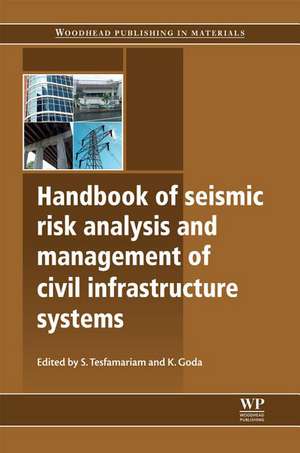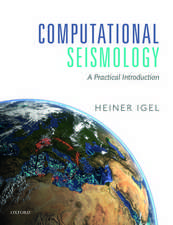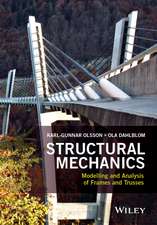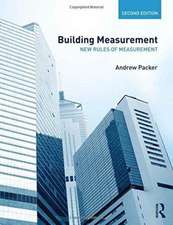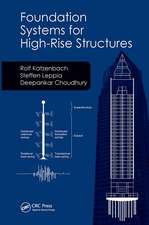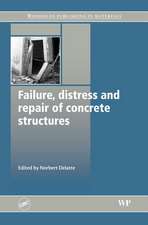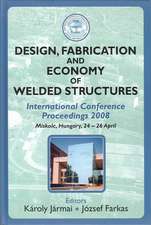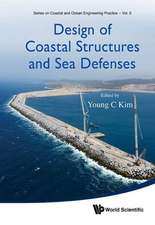Handbook of Seismic Risk Analysis and Management of Civil Infrastructure Systems: Woodhead Publishing Series in Civil and Structural Engineering
Editat de S Tesfamariam, K Godaen Limba Engleză Hardback – 29 apr 2013
Part one reviews research in the quantification of uncertainties in ground motion and seismic hazard assessment. Part twi discusses methodologies in seismic risk analysis and management, whilst parts three and four cover the application of seismic risk assessment to buildings, bridges, pipelines and other civil infrastructure systems. Part five also discusses methods for quantifying dependency between different infrastructure systems. The final part of the book considers ways of assessing financial and other losses from earthquake damage as well as setting insurance rates.
Handbook of seismic risk analysis and management of civil infrastructure systems is an invaluable guide for professionals requiring understanding of the impact of earthquakes on buildings and lifelines, and the seismic risk assessment and management of buildings, bridges and transportation. It also provides a comprehensive overview of seismic risk analysis for researchers and engineers within these fields.
- This important handbook reviews the wealth of recent research in the area of seismic hazard analysis in modern earthquake design code provisions and practices
- Examines research into the analysis of ground motion and seismic hazard assessment, seismic risk hazard methodologies
- Addresses the assessment of seismic risks to buildings, bridges, water supply systems and other aspects of civil infrastructure
Din seria Woodhead Publishing Series in Civil and Structural Engineering
- 29%
 Preț: 1333.83 lei
Preț: 1333.83 lei - 29%
 Preț: 1196.79 lei
Preț: 1196.79 lei - 9%
 Preț: 931.67 lei
Preț: 931.67 lei - 29%
 Preț: 1074.37 lei
Preț: 1074.37 lei - 39%
 Preț: 858.21 lei
Preț: 858.21 lei - 9%
 Preț: 805.54 lei
Preț: 805.54 lei - 29%
 Preț: 1329.07 lei
Preț: 1329.07 lei - 31%
 Preț: 1008.03 lei
Preț: 1008.03 lei - 27%
 Preț: 780.87 lei
Preț: 780.87 lei - 9%
 Preț: 1008.22 lei
Preț: 1008.22 lei - 29%
 Preț: 1333.96 lei
Preț: 1333.96 lei - 24%
 Preț: 874.91 lei
Preț: 874.91 lei - 29%
 Preț: 1195.75 lei
Preț: 1195.75 lei - 9%
 Preț: 1333.91 lei
Preț: 1333.91 lei - 28%
 Preț: 1140.27 lei
Preț: 1140.27 lei - 37%
 Preț: 683.84 lei
Preț: 683.84 lei - 9%
 Preț: 879.75 lei
Preț: 879.75 lei - 23%
 Preț: 1134.17 lei
Preț: 1134.17 lei - 24%
 Preț: 922.75 lei
Preț: 922.75 lei - 39%
 Preț: 1475.52 lei
Preț: 1475.52 lei - 9%
 Preț: 900.78 lei
Preț: 900.78 lei - 39%
 Preț: 901.38 lei
Preț: 901.38 lei - 23%
 Preț: 1083.03 lei
Preț: 1083.03 lei - 9%
 Preț: 1153.90 lei
Preț: 1153.90 lei - 24%
 Preț: 1048.97 lei
Preț: 1048.97 lei - 23%
 Preț: 1416.56 lei
Preț: 1416.56 lei - 9%
 Preț: 1107.70 lei
Preț: 1107.70 lei - 9%
 Preț: 1187.11 lei
Preț: 1187.11 lei - 23%
 Preț: 1129.24 lei
Preț: 1129.24 lei - 24%
 Preț: 986.08 lei
Preț: 986.08 lei - 28%
 Preț: 1285.96 lei
Preț: 1285.96 lei - 29%
 Preț: 1300.03 lei
Preț: 1300.03 lei - 29%
 Preț: 1280.31 lei
Preț: 1280.31 lei - 29%
 Preț: 1330.37 lei
Preț: 1330.37 lei - 9%
 Preț: 746.20 lei
Preț: 746.20 lei - 37%
 Preț: 683.94 lei
Preț: 683.94 lei - 23%
 Preț: 1202.24 lei
Preț: 1202.24 lei - 29%
 Preț: 1481.04 lei
Preț: 1481.04 lei - 9%
 Preț: 812.56 lei
Preț: 812.56 lei - 24%
 Preț: 1186.01 lei
Preț: 1186.01 lei - 9%
 Preț: 1357.19 lei
Preț: 1357.19 lei - 9%
 Preț: 842.75 lei
Preț: 842.75 lei - 39%
 Preț: 1189.20 lei
Preț: 1189.20 lei - 24%
 Preț: 1162.19 lei
Preț: 1162.19 lei - 24%
 Preț: 1007.79 lei
Preț: 1007.79 lei - 9%
 Preț: 1007.35 lei
Preț: 1007.35 lei - 23%
 Preț: 876.47 lei
Preț: 876.47 lei
Preț: 1516.67 lei
Preț vechi: 1982.06 lei
-23% Nou
Puncte Express: 2275
Preț estimativ în valută:
290.25€ • 301.91$ • 239.62£
290.25€ • 301.91$ • 239.62£
Carte tipărită la comandă
Livrare economică 07-21 aprilie
Preluare comenzi: 021 569.72.76
Specificații
ISBN-13: 9780857092687
ISBN-10: 0857092685
Pagini: 912
Dimensiuni: 156 x 234 x 48 mm
Greutate: 1.44 kg
Editura: ELSEVIER SCIENCE
Seria Woodhead Publishing Series in Civil and Structural Engineering
ISBN-10: 0857092685
Pagini: 912
Dimensiuni: 156 x 234 x 48 mm
Greutate: 1.44 kg
Editura: ELSEVIER SCIENCE
Seria Woodhead Publishing Series in Civil and Structural Engineering
Cuprins
Contributor contact details
Preface
Part I: Ground motions and seismic hazard assessment
Chapter 1: Probabilistic seismic hazard analysis of civil infrastructure
Abstract:
1.1 Introduction: past developments and current trends in assessing seismic risks
1.2 Simulation-based probabilistic seismic hazard analysis (PSHA)
1.3 Extension of probabilistic seismic hazard analysis (PSHA) to advanced earthquake engineering analyses
1.4 Conclusions and future trends
Chapter 2: Uncertainties in ground motion prediction in probabilistic seismic hazard analysis (PSHA) of civil infrastructure
Abstract:
2.1 Introduction
2.2 Explanation of ground-motion prediction equations (GMPEs)
2.3 Development of ground-motion prediction equations (GMPEs)
2.4 Sensitivity of model components
2.5 Future trends
2.6 Conclusions
Chapter 3: Spatial correlation of ground motions in estimating seismic hazards to civil infrastructure
Abstract:
3.1 Introduction
3.2 Spatial correlation of ground motions: evaluation and analysis
3.3 Ground-motion correlation and seismic loss assessment
3.4 Future trends
Chapter 4: Ground motion selection for seismic risk analysis of civil infrastructure
Abstract:
4.1 Introduction
4.2 Ground motion selection in seismic performance assessment
4.3 Case study: bridge foundation soil system
4.4 The generalized conditional intensity measure (GCIM) approach
4.5 Ground motion selection using generalized conditional intensity measure (GCIM)
4.6 Application of the ground motion selection methodology
4.7 Checking for bias in seismic response analysis due to ground motion selection
4.8 Seismic demand curve computation
4.9 Software implementations
4.10 Conclusions and future trends
Chapter 5: Assessing and managing the risk of earthquake-induced liquefaction to civil infrastructure
Abstract:
5.1 Introduction
5.2 Hazard identification
5.3 Hazard quantification
5.4 Response of infrastructure to liquefaction hazards
5.5 Tolerable risks and performance levels
5.6 Conclusions
Part II: Seismic risk analysis methodologies
Chapter 6: Seismic risk analysis and management of civil infrastructure systems: an overview
Abstract:
6.1 Introduction
6.2 Uncertainty in risk analysis
6.3 Risk analysis
6.4 Risk management
6.5 Conclusions
Chapter 7: Seismic risk analysis using Bayesian belief networks
Abstract:
7.1 Introduction
7.2 Bayesian belief networks (BBN)
7.3 Application of Bayesian belief networks (BBN) to seismic risk assessment: site-specific hazard assessment
7.4 Regional damage estimation
7.5 Vulnerability and damage assessment of individual buildings
7.6 Conclusions and future trends
Chapter 8: Structural vulnerability analysis of civil infrastructure facing seismic hazards
Abstract:
8.1 Introduction
8.2 Vulnerability, hazard and risk
8.3 Identification of vulnerability
8.4 Analysis of risk
8.5 Vulnerability of infrastructure networks
8.6 Advantages of vulnerability analysis
8.7 Conclusions
Chapter 9: Earthquake risk management of civil infrastructure: integrating soft and hard risks
Abstract:
9.1 Introduction: the inevitability of risk
9.2 Managing technical risks to structures
9.3 Reliability theory for the analysis of uncertainty and risk
9.4 Seismic vulnerability
9.5 Uncertainty: fuzziness, incompleteness and randomness (FIR)
9.6 Systems thinking
9.7 Process models and project progress maps (PPM)
9.8 Measuring evidence of performance
9.9 A structural example: procuring a new building
9.10 Conclusions
Chapter 10: A capability approach for seismic risk analysis and management
Abstract:
10.1 Introduction
10.2 Desiderata for a framework for seismic risk analysis and management
10.3 A capability approach for seismic risk analysis and management
10.5 Conclusions
10.6 Acknowledgments
Chapter 11: Resilience-based design (RBD) modelling of civil infrastructure to assess seismic hazards
Abstract:
11.1 Introduction
11.2 Development of performance-based design (PBD)
11.3 Towards resilience-based design (RBD)
11.4 Case studies
11.5 Conclusions
11.6 Future trends
11.7 Acknowledgements
Part III: Assessing seismic risks to buildings
Chapter 12: Assessing seismic risks for new and existing buildings using performance-based earthquake engineering (PBEE) methodology
Abstract:
12.1 Introduction
12.2 Performance-based earthquake engineering (PBEE) framework
12.3 Application: seismic performance assessment of high-rise buildings
12.4 Conclusions
12.5 Acknowledgments
Chapter 13: Assessing the seismic vulnerability of masonry buildings
Abstract:
13.1 Introduction
13.2 Vulnerability approaches: empirical and analytical
13.3 Collapse-mechanism approach to seismic vulnerability of masonry buildings
13.4 Stochastic and epistemic uncertainty quantification
13.5 Conclusions
Chapter 14: Vulnerability assessment of reinforced concrete structures for fire and earthquake risk
Abstract:
14.1 Introduction
14.2 Structural response to fire
14.3 Seismic response of structures
14.4 Fire performance of a reinforced concrete building following an earthquake
14.5 Residual seismic resistance of fire-damaged building columns
14.6 Lateral load resistance of a fire-damaged column using a hybrid method
14.7 Conclusions and future trends
Chapter 15: Seismic risk models for aging and deteriorating buildings and civil infrastructure
Abstract:
15.1 Introduction
15.2 Structural degradation
15.3 Shock-based damage accumulation models
15.4 Approximation to graceful deterioration
15.5 Combined progressive and shock-based deterioration
15.6 Conclusions
Chapter 16: Stochastic modeling of deterioration in buildings and civil infrastructure
Abstract:
16.1 Introduction
16.2 A general deterioration process
16.3 Modeling of a general deterioration process using the stochastic semi-analytical approach (SSA)
16.4 Stochastic modeling of deterioration in reinforced concrete (RC) bridges
16.5 Conclusions
Part IV: Assessing seismic risks to bridges and other components of civil infrastructure networks
Chapter 17: Risk assessment and management of civil infrastructure networks: a systems approach
Abstract:
17.1 Introduction
17.2 Systems and networks
17.3 Hierarchical representation of networks
17.4 Risk assessment of infrastructure networks
17.5 Optimal resource allocation in infrastructure networks
17.6 Conclusions
Chapter 18: Seismic vulnerability analysis of a complex interconnected civil infrastructure
Abstract:
18.1 Introduction and definitions
18.2 Time, space and stakeholder dimensions of the problem
18.3 Model, analysis type and interactions
18.4 Object-oriented model (OOM) of the infrastructure and hazards
18.5 Description of the main classes
18.6 Performance metrics
18.7 Probabilistic assessment of the model
18.8 Example of an application of seismic vulnerability analysis
18.9 Future trends
18.10 Acknowledgements
Chapter 19: Seismic reliability of deteriorating reinforced concrete (RC) bridges
Abstract:
19.1 Introduction
19.2 Mechanisms of deterioration
19.3 Effects of deterioration on the reliability of bridges
19.4 Conclusions
Chapter 20: Using a performance-based earthquake engineering (PBEE) approach to estimate structural performance targets for bridges
Abstract:
20.1 Introduction
20.2 Performance-based seismic evaluation framework (PEER approach)
20.3 Probabilistic seismic demand analysis (PSDA)
20.4 Vector-valued probabilistic seismic hazard assessment (VPSHA)
20.5 Performance-based seismic evaluation of ordinary highway bridges
20.6 Future trends
20.7 Acknowledgments
Chapter 21: Incremental dynamic analysis (IDA) applied to seismic risk assessment of bridges
Abstract:
21.1 Introduction
21.2 Incremental dynamic analysis (IDA)
21.3 Structural modelling for incremental dynamic analysis (IDA)
21.4 Sources of uncertainty
21.5 Record selection for incremental dynamic analysis (IDA)
21.6 Development of fragility curves using incremental dynamic analysis (IDA) results
21.7 Case study for a continuous 4-span bridge
21.8 Conclusions and future trends
Chapter 22: Effect of soil–structure interaction and spatial variability of ground motion on seismic risk assessment of bridges
Abstract:
22.1 Introduction
22.2 Soil–foundation–pier–superstructure interaction
22.3 Embankment–backfill–abutment–superstructure interaction
22.4 Realistic earthquake excitation scenarios for interactive soil–bridge systems
22.5 Conclusions
Chapter 23: Seismic risk management for water pipeline networks
Abstract:
23.1 Introduction
23.2 Seismic failure of a lifeline system
23.3 Seismic risk assessment
23.4 Seismic risk mitigation
23.5 Future trends
Chapter 24: Seismic risk assessment of water supply systems
Abstract:
24.1 Introduction
24.2 General framework for evaluating seismic risk
24.3 System characteristics
24.4 Seismic hazards
24.5 Component responses
24.6 System responses
24.7 Economic and social consequences
24.8 Future trends
24.9 Sources of further information and advice
24.10 Acknowledgments
Chapter 25: Seismic risk assessment for oil and gas pipelines
Abstract:
25.1 Introduction
25.2 Purpose of performing a risk assessment
25.3 Key steps in performing risk assessments for oil and gas pipelines
25.4 Types of seismic hazard
25.2 Determining hazard likelihood
25.6 Determining severity of hazard
25.7 Pipeline response to earthquake hazards
25.8 Consequences of pipeline damage
25.9 Mitigation approaches to reduce risk to pipelines
25.10 Challenges and issues
25.11 Future trends
25.12 Conclusions
Chapter 26: Seismic risk analysis of wind turbine support structures
Abstract:
26.1 Introduction
26.2 Probabilistic demand models
26.3 Demand models for the support structure of offshore wind turbines
26.4 Example of fragility estimates for an offshore wind turbine support structure
26.5 Conclusions
26.6 Future trends
26.7 Acknowledgments
Part V: Assessing financial and other losses from earthquake damage
Chapter 27: Seismic risk and possible maximum loss (PML) analysis of reinforced concrete structures
Abstract:
27.1 Introduction
27.2 Analytical procedure for assessing seismic risk
27.3 Case studies of seismic risk analysis for reinforced concrete structures
27.4 Conclusions and future trends
Chapter 28: Seismic risk management of insurance losses using extreme value theory and copula
Abstract:
28.1 Introduction
28.2 Statistical modelling of extreme data
28.3 Insurer’s earthquake risk exposure modelling
28.4 Earthquake insurance portfolio analysis
28.5 Conclusions and future trends
Chapter 29: Probabilistic assessment of earthquake insurance rates for buildings
Abstract:
29.1 Introduction
29.2 Probabilistic model for the assessment of earthquake insurance rates
29.3 Application: assessment of earthquake insurance rates for different seismic zones in Turkey
29.4 Implementation of earthquake insurance: Turkish Catastrophe Insurance Pool (TCIP)
29.5 Conclusions and future trends
29.6 Acknowledgments
Chapter 30: Assessing global earthquake risks: the Global Earthquake Model (GEM) initiative
Abstract:
30.1 Introduction
30.2 Current status of Global Earthquake Model (GEM)1
30.3 OpenQuake
30.4 Outlook for Global Earthquake Model (GEM)
Chapter 31: Strategies for rapid global earthquake impact estimation: the Prompt Assessment of Global Earthquakes for Response (PAGER) system
Abstract:
31.1 Introduction
31.2 State-of-the-art of rapid earthquake loss estimation systems
31.3 Prompt Assessment of Global Earthquakes for Response (PAGER) system development
31.4 Earthquake loss models within the Prompt Assessment of Global Earthquakes for Response (PAGER) system
31.5 Earthquake impact scale
31.6 Loss estimation for recent earthquakes
31.7 Prompt Assessment of Global Earthquakes for Response (PAGER) products and ongoing developments
31.8 Conclusions
31.9 Acknowledgments
Index
Preface
Part I: Ground motions and seismic hazard assessment
Chapter 1: Probabilistic seismic hazard analysis of civil infrastructure
Abstract:
1.1 Introduction: past developments and current trends in assessing seismic risks
1.2 Simulation-based probabilistic seismic hazard analysis (PSHA)
1.3 Extension of probabilistic seismic hazard analysis (PSHA) to advanced earthquake engineering analyses
1.4 Conclusions and future trends
Chapter 2: Uncertainties in ground motion prediction in probabilistic seismic hazard analysis (PSHA) of civil infrastructure
Abstract:
2.1 Introduction
2.2 Explanation of ground-motion prediction equations (GMPEs)
2.3 Development of ground-motion prediction equations (GMPEs)
2.4 Sensitivity of model components
2.5 Future trends
2.6 Conclusions
Chapter 3: Spatial correlation of ground motions in estimating seismic hazards to civil infrastructure
Abstract:
3.1 Introduction
3.2 Spatial correlation of ground motions: evaluation and analysis
3.3 Ground-motion correlation and seismic loss assessment
3.4 Future trends
Chapter 4: Ground motion selection for seismic risk analysis of civil infrastructure
Abstract:
4.1 Introduction
4.2 Ground motion selection in seismic performance assessment
4.3 Case study: bridge foundation soil system
4.4 The generalized conditional intensity measure (GCIM) approach
4.5 Ground motion selection using generalized conditional intensity measure (GCIM)
4.6 Application of the ground motion selection methodology
4.7 Checking for bias in seismic response analysis due to ground motion selection
4.8 Seismic demand curve computation
4.9 Software implementations
4.10 Conclusions and future trends
Chapter 5: Assessing and managing the risk of earthquake-induced liquefaction to civil infrastructure
Abstract:
5.1 Introduction
5.2 Hazard identification
5.3 Hazard quantification
5.4 Response of infrastructure to liquefaction hazards
5.5 Tolerable risks and performance levels
5.6 Conclusions
Part II: Seismic risk analysis methodologies
Chapter 6: Seismic risk analysis and management of civil infrastructure systems: an overview
Abstract:
6.1 Introduction
6.2 Uncertainty in risk analysis
6.3 Risk analysis
6.4 Risk management
6.5 Conclusions
Chapter 7: Seismic risk analysis using Bayesian belief networks
Abstract:
7.1 Introduction
7.2 Bayesian belief networks (BBN)
7.3 Application of Bayesian belief networks (BBN) to seismic risk assessment: site-specific hazard assessment
7.4 Regional damage estimation
7.5 Vulnerability and damage assessment of individual buildings
7.6 Conclusions and future trends
Chapter 8: Structural vulnerability analysis of civil infrastructure facing seismic hazards
Abstract:
8.1 Introduction
8.2 Vulnerability, hazard and risk
8.3 Identification of vulnerability
8.4 Analysis of risk
8.5 Vulnerability of infrastructure networks
8.6 Advantages of vulnerability analysis
8.7 Conclusions
Chapter 9: Earthquake risk management of civil infrastructure: integrating soft and hard risks
Abstract:
9.1 Introduction: the inevitability of risk
9.2 Managing technical risks to structures
9.3 Reliability theory for the analysis of uncertainty and risk
9.4 Seismic vulnerability
9.5 Uncertainty: fuzziness, incompleteness and randomness (FIR)
9.6 Systems thinking
9.7 Process models and project progress maps (PPM)
9.8 Measuring evidence of performance
9.9 A structural example: procuring a new building
9.10 Conclusions
Chapter 10: A capability approach for seismic risk analysis and management
Abstract:
10.1 Introduction
10.2 Desiderata for a framework for seismic risk analysis and management
10.3 A capability approach for seismic risk analysis and management
10.5 Conclusions
10.6 Acknowledgments
Chapter 11: Resilience-based design (RBD) modelling of civil infrastructure to assess seismic hazards
Abstract:
11.1 Introduction
11.2 Development of performance-based design (PBD)
11.3 Towards resilience-based design (RBD)
11.4 Case studies
11.5 Conclusions
11.6 Future trends
11.7 Acknowledgements
Part III: Assessing seismic risks to buildings
Chapter 12: Assessing seismic risks for new and existing buildings using performance-based earthquake engineering (PBEE) methodology
Abstract:
12.1 Introduction
12.2 Performance-based earthquake engineering (PBEE) framework
12.3 Application: seismic performance assessment of high-rise buildings
12.4 Conclusions
12.5 Acknowledgments
Chapter 13: Assessing the seismic vulnerability of masonry buildings
Abstract:
13.1 Introduction
13.2 Vulnerability approaches: empirical and analytical
13.3 Collapse-mechanism approach to seismic vulnerability of masonry buildings
13.4 Stochastic and epistemic uncertainty quantification
13.5 Conclusions
Chapter 14: Vulnerability assessment of reinforced concrete structures for fire and earthquake risk
Abstract:
14.1 Introduction
14.2 Structural response to fire
14.3 Seismic response of structures
14.4 Fire performance of a reinforced concrete building following an earthquake
14.5 Residual seismic resistance of fire-damaged building columns
14.6 Lateral load resistance of a fire-damaged column using a hybrid method
14.7 Conclusions and future trends
Chapter 15: Seismic risk models for aging and deteriorating buildings and civil infrastructure
Abstract:
15.1 Introduction
15.2 Structural degradation
15.3 Shock-based damage accumulation models
15.4 Approximation to graceful deterioration
15.5 Combined progressive and shock-based deterioration
15.6 Conclusions
Chapter 16: Stochastic modeling of deterioration in buildings and civil infrastructure
Abstract:
16.1 Introduction
16.2 A general deterioration process
16.3 Modeling of a general deterioration process using the stochastic semi-analytical approach (SSA)
16.4 Stochastic modeling of deterioration in reinforced concrete (RC) bridges
16.5 Conclusions
Part IV: Assessing seismic risks to bridges and other components of civil infrastructure networks
Chapter 17: Risk assessment and management of civil infrastructure networks: a systems approach
Abstract:
17.1 Introduction
17.2 Systems and networks
17.3 Hierarchical representation of networks
17.4 Risk assessment of infrastructure networks
17.5 Optimal resource allocation in infrastructure networks
17.6 Conclusions
Chapter 18: Seismic vulnerability analysis of a complex interconnected civil infrastructure
Abstract:
18.1 Introduction and definitions
18.2 Time, space and stakeholder dimensions of the problem
18.3 Model, analysis type and interactions
18.4 Object-oriented model (OOM) of the infrastructure and hazards
18.5 Description of the main classes
18.6 Performance metrics
18.7 Probabilistic assessment of the model
18.8 Example of an application of seismic vulnerability analysis
18.9 Future trends
18.10 Acknowledgements
Chapter 19: Seismic reliability of deteriorating reinforced concrete (RC) bridges
Abstract:
19.1 Introduction
19.2 Mechanisms of deterioration
19.3 Effects of deterioration on the reliability of bridges
19.4 Conclusions
Chapter 20: Using a performance-based earthquake engineering (PBEE) approach to estimate structural performance targets for bridges
Abstract:
20.1 Introduction
20.2 Performance-based seismic evaluation framework (PEER approach)
20.3 Probabilistic seismic demand analysis (PSDA)
20.4 Vector-valued probabilistic seismic hazard assessment (VPSHA)
20.5 Performance-based seismic evaluation of ordinary highway bridges
20.6 Future trends
20.7 Acknowledgments
Chapter 21: Incremental dynamic analysis (IDA) applied to seismic risk assessment of bridges
Abstract:
21.1 Introduction
21.2 Incremental dynamic analysis (IDA)
21.3 Structural modelling for incremental dynamic analysis (IDA)
21.4 Sources of uncertainty
21.5 Record selection for incremental dynamic analysis (IDA)
21.6 Development of fragility curves using incremental dynamic analysis (IDA) results
21.7 Case study for a continuous 4-span bridge
21.8 Conclusions and future trends
Chapter 22: Effect of soil–structure interaction and spatial variability of ground motion on seismic risk assessment of bridges
Abstract:
22.1 Introduction
22.2 Soil–foundation–pier–superstructure interaction
22.3 Embankment–backfill–abutment–superstructure interaction
22.4 Realistic earthquake excitation scenarios for interactive soil–bridge systems
22.5 Conclusions
Chapter 23: Seismic risk management for water pipeline networks
Abstract:
23.1 Introduction
23.2 Seismic failure of a lifeline system
23.3 Seismic risk assessment
23.4 Seismic risk mitigation
23.5 Future trends
Chapter 24: Seismic risk assessment of water supply systems
Abstract:
24.1 Introduction
24.2 General framework for evaluating seismic risk
24.3 System characteristics
24.4 Seismic hazards
24.5 Component responses
24.6 System responses
24.7 Economic and social consequences
24.8 Future trends
24.9 Sources of further information and advice
24.10 Acknowledgments
Chapter 25: Seismic risk assessment for oil and gas pipelines
Abstract:
25.1 Introduction
25.2 Purpose of performing a risk assessment
25.3 Key steps in performing risk assessments for oil and gas pipelines
25.4 Types of seismic hazard
25.2 Determining hazard likelihood
25.6 Determining severity of hazard
25.7 Pipeline response to earthquake hazards
25.8 Consequences of pipeline damage
25.9 Mitigation approaches to reduce risk to pipelines
25.10 Challenges and issues
25.11 Future trends
25.12 Conclusions
Chapter 26: Seismic risk analysis of wind turbine support structures
Abstract:
26.1 Introduction
26.2 Probabilistic demand models
26.3 Demand models for the support structure of offshore wind turbines
26.4 Example of fragility estimates for an offshore wind turbine support structure
26.5 Conclusions
26.6 Future trends
26.7 Acknowledgments
Part V: Assessing financial and other losses from earthquake damage
Chapter 27: Seismic risk and possible maximum loss (PML) analysis of reinforced concrete structures
Abstract:
27.1 Introduction
27.2 Analytical procedure for assessing seismic risk
27.3 Case studies of seismic risk analysis for reinforced concrete structures
27.4 Conclusions and future trends
Chapter 28: Seismic risk management of insurance losses using extreme value theory and copula
Abstract:
28.1 Introduction
28.2 Statistical modelling of extreme data
28.3 Insurer’s earthquake risk exposure modelling
28.4 Earthquake insurance portfolio analysis
28.5 Conclusions and future trends
Chapter 29: Probabilistic assessment of earthquake insurance rates for buildings
Abstract:
29.1 Introduction
29.2 Probabilistic model for the assessment of earthquake insurance rates
29.3 Application: assessment of earthquake insurance rates for different seismic zones in Turkey
29.4 Implementation of earthquake insurance: Turkish Catastrophe Insurance Pool (TCIP)
29.5 Conclusions and future trends
29.6 Acknowledgments
Chapter 30: Assessing global earthquake risks: the Global Earthquake Model (GEM) initiative
Abstract:
30.1 Introduction
30.2 Current status of Global Earthquake Model (GEM)1
30.3 OpenQuake
30.4 Outlook for Global Earthquake Model (GEM)
Chapter 31: Strategies for rapid global earthquake impact estimation: the Prompt Assessment of Global Earthquakes for Response (PAGER) system
Abstract:
31.1 Introduction
31.2 State-of-the-art of rapid earthquake loss estimation systems
31.3 Prompt Assessment of Global Earthquakes for Response (PAGER) system development
31.4 Earthquake loss models within the Prompt Assessment of Global Earthquakes for Response (PAGER) system
31.5 Earthquake impact scale
31.6 Loss estimation for recent earthquakes
31.7 Prompt Assessment of Global Earthquakes for Response (PAGER) products and ongoing developments
31.8 Conclusions
31.9 Acknowledgments
Index
Recenzii
"...this Handbook should be a basic reference for all professionals, from researchers to practitioners and decision makers, involved in seismic risk analysis and management." --Journal of Seismology, July 1 2014
